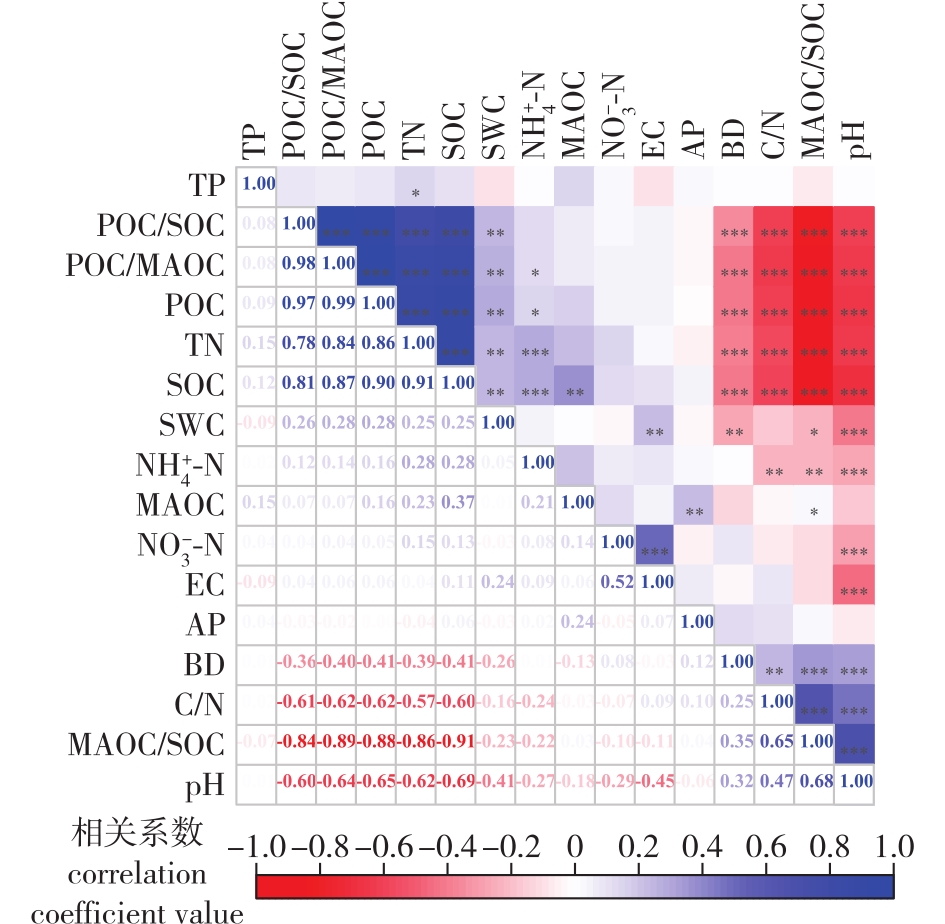 PDF(2212 KB)
PDF(2212 KB)


The variation characteristics of particulate organic carbon and mineral-associated organic carbon during the development of Metasequoia glyptostroboides plantations
ZHAI Ningning, SHI Ke, RUAN Honghua, NI Juanping, FANG Yu, CAO Guohua, SHEN Caiqin, XU Yaming, HUO Jianjun
Journal of Nanjing Forestry University (Natural Sciences Edition) ›› 2025, Vol. 49 ›› Issue (3) : 25-32.
 PDF(2212 KB)
PDF(2212 KB)
 PDF(2212 KB)
PDF(2212 KB)
The variation characteristics of particulate organic carbon and mineral-associated organic carbon during the development of Metasequoia glyptostroboides plantations
【Objective】Plantations play significant roles in mitigating climate change. Understanding the dynamics of soil organic carbon (SOC), particularly through its key components—particulate organic carbon (POC) and mineral-associated organic carbon (MAOC)—is crucial for predicting carbon sequestration in soil.【Method】This study investigated Metasequoia glyptostroboides plantations of varying ages (7, 16, 21, 26, 31, 36, 42 and 46 a) located in the Dongtai Forest Farm, Jiangsu Province. For each forest age, four replicated field plots were established, and soil samples were collected from five distinct depths: [0, 20), [20, 40), [40, 60), [60, 80), and [80, 100) cm. A range of soil physicochemical properties—including pH, ammonium nitrogen, nitrate nitrogen, total phosphorus, and available phosphorus—along with SOC fractions (POC and MAOC) were measured to examine the variation in POC and MAOC with the development of the plantations.【Result】POC in the [0, 20) cm soil layer was the dominant contributor to the soil organic carbon pool, and its accumulation was enhanced during the plantation’s development. Conversely, MAOC was the predominant fraction in the [20, 40) cm soil layer, but its response to stand age and development was less pronounced. As the forest age increased, the stability of SOC in the [0, 20) cm layer declined, making it more susceptible to decomposition and utilization. In contrast, SOC stability in the [20, 100) cm layers remained higher, supporting longer-term organic carbon storage. Correlation analysis revealed that POC was more responsive to environmental changes driven by stand development compared to MAOC.【Conclusion】As plantations mature, soil organic carbon accumulates primarily in the surface layer [(0, 20) cm] in the form of POC. The greatest accumulation occurs during the over-mature stage of the forest. Long-term plantation development significantly enhances the accumulation and retention of different fractions of surface soil organic carbon. Therefore, extending the primary cutting age of plantations would further optimize their role in mitigating global climate change.

Metasequoia glyptostroboides plantations / particulate organic carbon(POC) / mineral-associated organic carbon(MAOC) / stand development / deep soil
| [1] |
|
| [2] |
|
| [3] |
|
| [4] |
|
| [5] |
|
| [6] |
|
| [7] |
|
| [8] |
|
| [9] |
|
| [10] |
|
| [11] |
|
| [12] |
|
| [13] |
|
| [14] |
胡建文, 刘常富, 勾蒙蒙, 等. 林龄对马尾松人工林微生物残体碳积累的影响机制[J]. 应用生态学报, 2024, 35(1):153-160.
|
| [15] |
问宇翔, 冯坤乔, 童冉, 等. 水杉人工林细根和粗根碳氮磷计量特征对N添加的响应[J]. 林业科学研究, 2022, 35(3):161-168.
|
| [16] |
庄红蕾. 上海崇明岛水杉人工林生态系统碳动态研究[D]. 上海: 上海交通大学, 2012.
|
| [17] |
李佩聪. 环境水体中基于邻苯基苯酚:靛酚蓝分光光度法的铵氮测定新方法的研究和应用[D]. 厦门大学, 2019.
|
| [18] |
国家海洋局. 海洋监测规范第4部分:海水分析:GB 17378.4—2007[S]. 北京: 中国标准出版社, 2008.
State Ocean Administration of the PRC. The specification for marine monitoring:part 4:seawater analysis:GB 17378.4—2007[S]. Beijing: Standards Press of China, 2008.
|
| [19] |
国家林业局. 森林土壤磷的测定:LY/T 1232—2015[S]. 北京: 中国标准出版社, 2016.
State Forestry Administration of State Ocean Administration of the PRC. Phosphorus determination methods of forest soils:LY/T 1232—2015[S]. Beijing: Standards Press of China, 2016.
|
| [20] |
索伦嘎. 围封对羊草草原植被—土壤特征的影响:聚焦土壤有机碳组分变化[D]. 呼和浩特: 内蒙古大学, 2022.
|
| [21] |
|
| [22] |
肖春波, 王海, 范凯峰, 等. 崇明岛不同年龄水杉人工林生态系统碳储量的特点及估测[J]. 上海交通大学学报(农业科学版), 2010, 28(1):30-34.
|
| [23] |
谢天时. 不同林龄水杉人工林群落特征比较研究[J]. 福建林业科技, 2007, 34(2):19-23.
|
| [24] |
|
| [25] |
江苏省林业局. 江苏省森林资源规划设计调查操作细则[Z]. 南京:江苏省林业局, 2007.
Forestry Bureau of Jiangsu Province. Operation rules of forest resources planning and design survey of Jiangsu Province[Z]. Nanjing: Forestry Bureau of Jiangsu Province, 2007.
|
| [26] |
|
| [27] |
刘江伟, 徐海东, 林同岳, 等. 海涂围垦区不同林分土壤活性有机碳垂直变化特征[J]. 林业科学研究, 2022, 35(3):18-26.
|
| [28] |
|
| [29] |
侯超, 张申平, 马跃龙. 特异性乳糖酶的开发研究进展[J]. 生物加工过程, 2024, 22(1):81-88.
|
| [30] |
|
| [31] |
曹国华, 姚继周, 杨鑫, 等. 水杉人工林细根形态及生物量分布规律[J]. 安徽农业科学, 2016, 44(2):9-11.
|
| [32] |
|
| [33] |
|
| [34] |
|
| [35] |
|
| [36] |
|
| [37] |
|
| [38] |
|
| [39] |
|
| [40] |
|
/
| 〈 |
|
〉 |